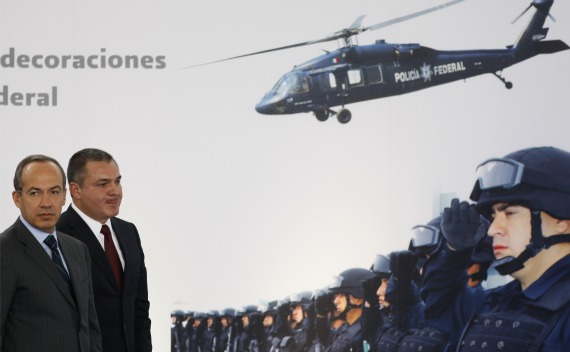Evaluating Mexico’s “New Security Model”
More on:

Mexico’s recent state level elections informally hail the beginning of the presidential election season. The PRI triumph positions Enrique Peña Nieto, the outgoing State of Mexico governor, as the PRI’s candidate, and the one which everyone must beat.
As the politicking begins, so too does the legacy shaping. And here for the current administration no issue is more important than security. Perhaps the hallmark of the Calderón administration has been the creation of the Federal Police. Genaro Garcia Luna, the Secretary of Public Security (SSP) and head of this new force has just released a new book, Para Entender: El Nuevo Modelo de Seguridad to explain Mexico’s “New Security Model.” It is worth a read in order to understand what the government is officially trying to do – then one can judge how far it has progressed down that path.
Mexico’s new model comprises three essential parts. The first is technology – led by the much heralded Plataforma México, a comprehensive national crime database. Its goal is to make information easily accessible, searchable, and actionable for law enforcement across the nation. The second is people, working to make “Mexico’s finest” live up to the moniker. This involves creating a truly professional force through new ways of recruiting, vetting, training, and career planning. It has also meant changing the Constitution to give the federal police more powers than they previously had, including the ability to investigate crimes. The third arm is the prison system, seen more often as both a revolving door for powerful criminals and a training ground for those just starting out. The model envisions expanding and upgrading the current overcrowded and run-down facilities and professionalizing the staff.
The book gives a strong vision of the reasons, goals, and processes behind the administration’s police reforms, which they hope will truly transform Mexico’s security situation. This work now needs to be complemented by analyses of how much progress has been made so far in making this aspiration a reality. Some of the preliminary figures out there are promising: the number of federal police officers has risen from nearly 6,500 when Calderón took office to the current 35,000. More than 7,000 - or roughly 20% —are college educated, practically unheard of under previous national level forces.
But other numbers are more worrisome. The crime reports submitted (called Informes Policiales Homologados, or IPHs) to Plataforma México are uneven and overall sobering. Sources show that many municipalities and states submit less than one report a month. Plataforma México – no matter how sophisticated the technology -- is only as good as its inputs. Recruitment too has been a problem, particularly the search for more skilled and educated, to the point of leaving positions unfilled.
Also left relatively untouched in Luna’s book is his agency’s relationship with the Attorney General’s office, the PGR. During the creation of this new model, the fights between the PGR and SSP were legendary, and undoubtedly some hard feelings remain. But for Mexico to reduce violence and crime, the links and cooperation between these two branches is vital. How evidence is collected and handed off, how federal police do, should, and will work with prosecutors remains unclear – even in the book’s visionary schematic.
Calderón’s legacy will depend on the security situation not just when he steps down at the end of 2012, but over the next generation. If the new Federal Police strengthens and the vision expands to include state and local forces; if the judicial reforms are implemented, transforming Mexico’s system of justice; and if these two law enforcement branches learn to work together, then it will look very good indeed. But these are still big ifs. The legislative battles and international agreements are perhaps the easiest part of Mexico’s institutional transformation. The hardest slog will be in the bureaucratic trenches, trying to change the on-the-ground ways of doing things. It is this challenge that the next President – and Mexico more generally-- still faces.
More on:
 Online Store
Online Store